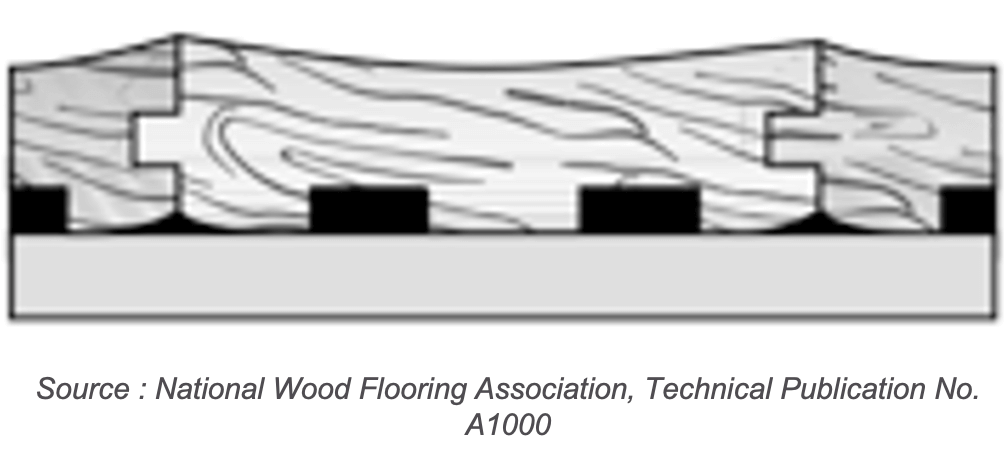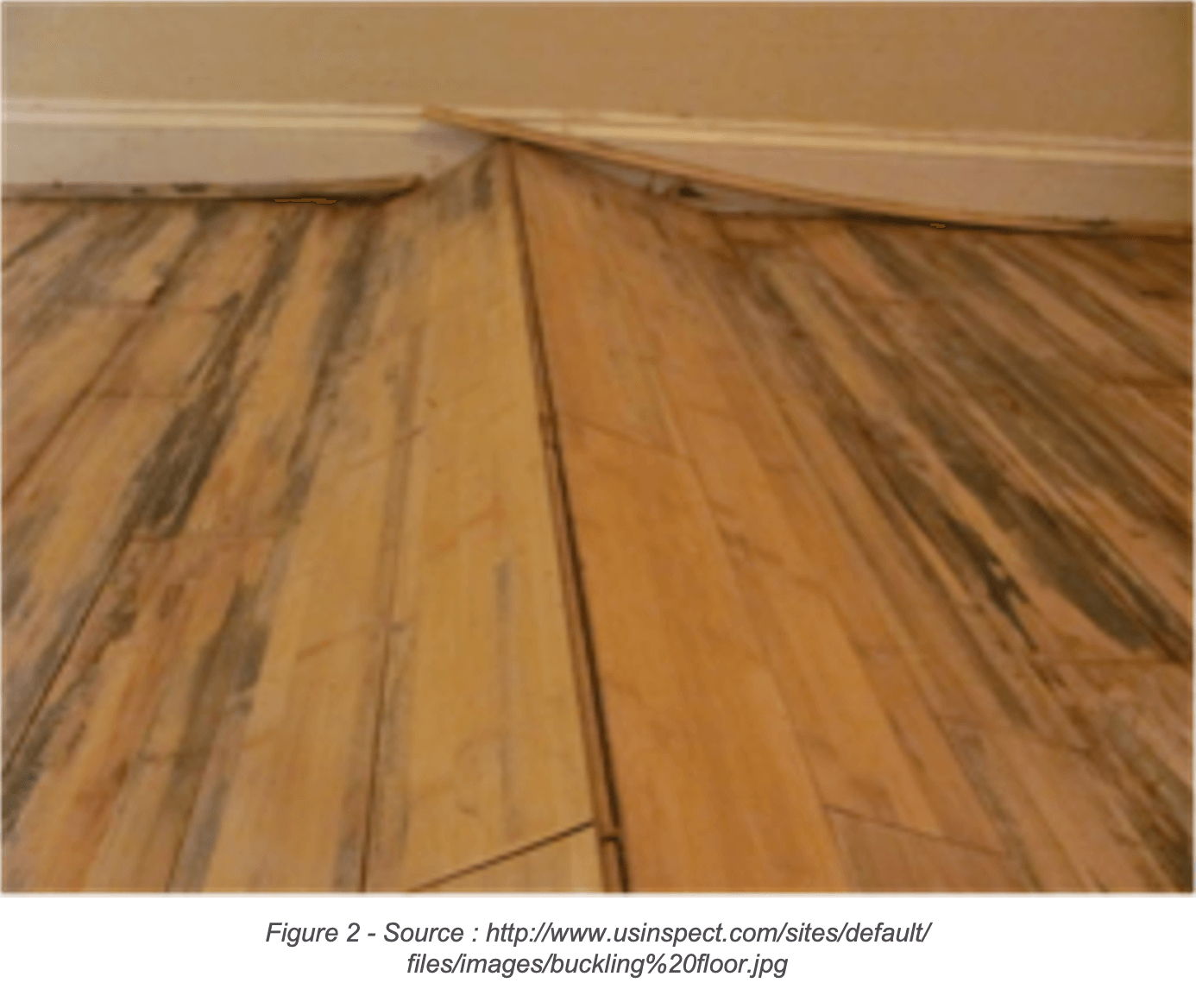General effect on wood
It is well known that the moisture content of a piece of wood affects its properties. Indeed, when a piece of wood is dried naturally or in a kiln dryer, a decrease of the volume or shrinkage occurs. The effect is reversed (expansion) when the moisture content increases in the material.
The dimensional change occurs mainly on the diameter of the fiber. Thus, a wood plank will be mainly affected on its width and thickness, and slightly on its length. Moreover, the amplitude of the dimensional change varies in function of moisture content and differs according to the variety of wood, as shown on the following chart:
| Common Varieties of Wood | Dimensional Change Coefficient [in/in*%humidity] |
|---|---|
| Teck | 0,00186 |
| Black Cherry | 0,00248 |
| Douglas Fir | 0,00267 |
| Hard Maple | 0,00353 |
| Red Oak | 0,00369 |
| Brazilian Cherry | 0,003 |
| OSB Panel | between 0.003 and 0.0035 |
Source : National Wood Flooring Association
Hardwood floorings
On hardwood floorings, damage caused by humidity can occur in several ways.
First, there is the concave warping (cupping) that shows when the moisture content is higher under the hardwood flooring than on top of it. The base of the wood plank is prone to expand while it is restrained on both sides. The sides then lift up, which creates concave warping (figure 1).
An extreme case of damage due to high moisture content is the lifting of the flooring (buckling, figure 2). This phenomenon can also occur when an inadequate type of fastener is used.
Another type of damage is the appearance of spaces between the planks. Those manifestations appear when the surrounding relative  humidity is significantly lower than the level of relative humidity during the installation. This type of damage often occurs during winter, when the relative humidity is low. The spaces then disappear or decrease during summer.
humidity is significantly lower than the level of relative humidity during the installation. This type of damage often occurs during winter, when the relative humidity is low. The spaces then disappear or decrease during summer.
Most of the typical movements and damage to hardwood floorings resulting from humidity are caused by a direct exposure to water (for example, after a water damage) or by unstable ambient conditions (humidity and temperature). The wider are the planks, the more intense will be the effect.
The engineered- and floating-type wood floorings are dimensionally more stable. They can easily be installed in a basement, as opposed to the hardwood floorings that should only be installed at ground floor and upper levels.
Resilient Floorings
In the case of resilient floorings, such as linoleum and vinyl, the humidity can also cause damage. Indeed, in the case where those materials are installed on the underlay of plywood panels or oriented strand boards (OSB) while it has high moisture content, shrinkage due to the gradual drying process of the panel will occur, notably on its thickness.
Consequently, the head of the fixing screws of the underlay will tend to resurface. This will show by visible bumps on the surface of the resilient flooring. This type of damage will generally appear on the floor, even in the areas where there is little or no human activity (for example, under a bed).
Humidity sources
The humidity sources that can create damage to floorings are numerous. In new buildings, the tighter construction schedule can lead to extra humidity sources. Among those, rain on the structure before the installation of the roof as well as humidity coming from the new concrete foundations can contribute to increase the water load contained in the ambient air.
Also, the new construction standards (such as Novoclimat) provide increased air-tightness of the building envelope. Mechanical ventilation is therefore required in order to maintain acceptable temperature and humidity conditions. Without this mechanical system, the humidity accumulates in the building and problems can arise.
The daily activities of the occupants can also cause an increase of the humidity, for example if an unoccupied room is left without heating or air conditioning or, if no dehumidifier is used despite the humidity in the rooms.
Example of hardwood-flooring movements
Let’s consider a 15 feet wide floor covered with maple wood flooring with 3 ½ inches wide planks (total of 50 planks). During the installation, the moisture content of the wood was evaluated to 6 %. During the summer, the equilibrium moisture content level (EMC) reaches 9 %.
The expansion of the flooring will then be the following:
For a plank: 3.5 [in] X 3 [%] X 0.00353 [in/in*% humidity] = 0.037 in.
For the floor: 0.0037[in/plank] X 50 [planks] = 1.850 in.
In reality, because the planks are nailed to the underlay, the movement will somewhat be diminished.
How to limit the problems
In order to limit the problems, the humidity of the materials composing the underlay and the flooring should be measured using appropriate instruments before the installation. The moisture content should be about the same as the one existing with a normal use of the building. In Quebec, the equilibrium moisture content in a house fluctuates between 6 % and 11 %.
Most of the hardwood-flooring manufacturers stipulate that the materials should be acclimatized to the room in which they will be installed for a certain period of time before the installation. With this in mind, the situations where the flooring is installed while the doors and windows are not yet installed or that the HVAC devices usually in use are not in operation are not recommended.
For the hardwood floors, the installation of an appropriate felt paper moisture retarder between the underlay and the flooring is recommended. There should be a space left near the walls in order to allow the natural movement of the flooring.
Conclusion
In the event of damage and flooring movements, the identification of the probable cause requires consideration of the site examination and the collection of information, from the installation of the flooring to the occupants’ activities in the building. Based on this information, our mechanical engineers will be able to identify the probable cause of the damage.
For more information or to talk about a claim with one of our experts, contact our Mechanical Engineering team at 877 686-0240 or info@cep-experts.ca.
